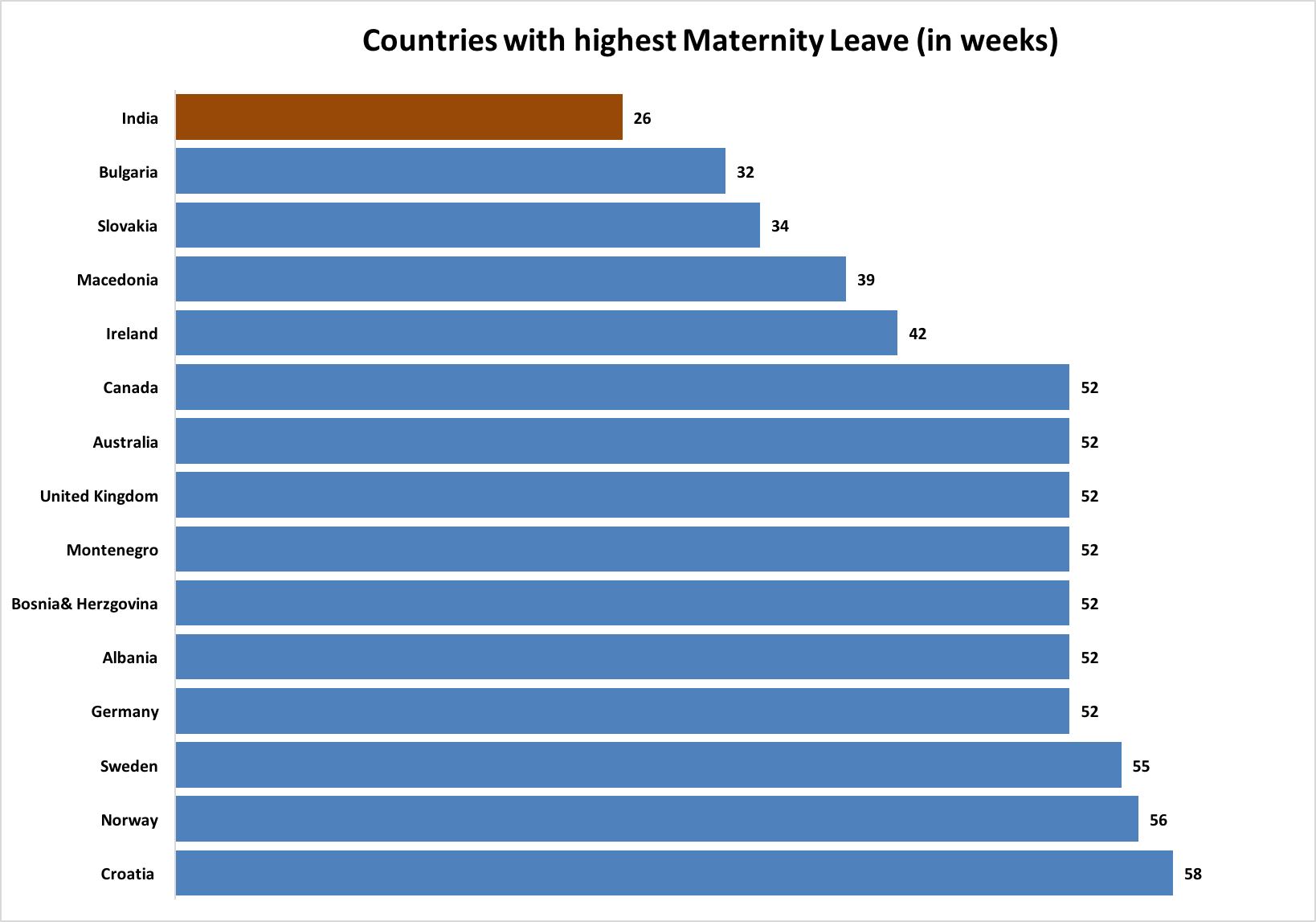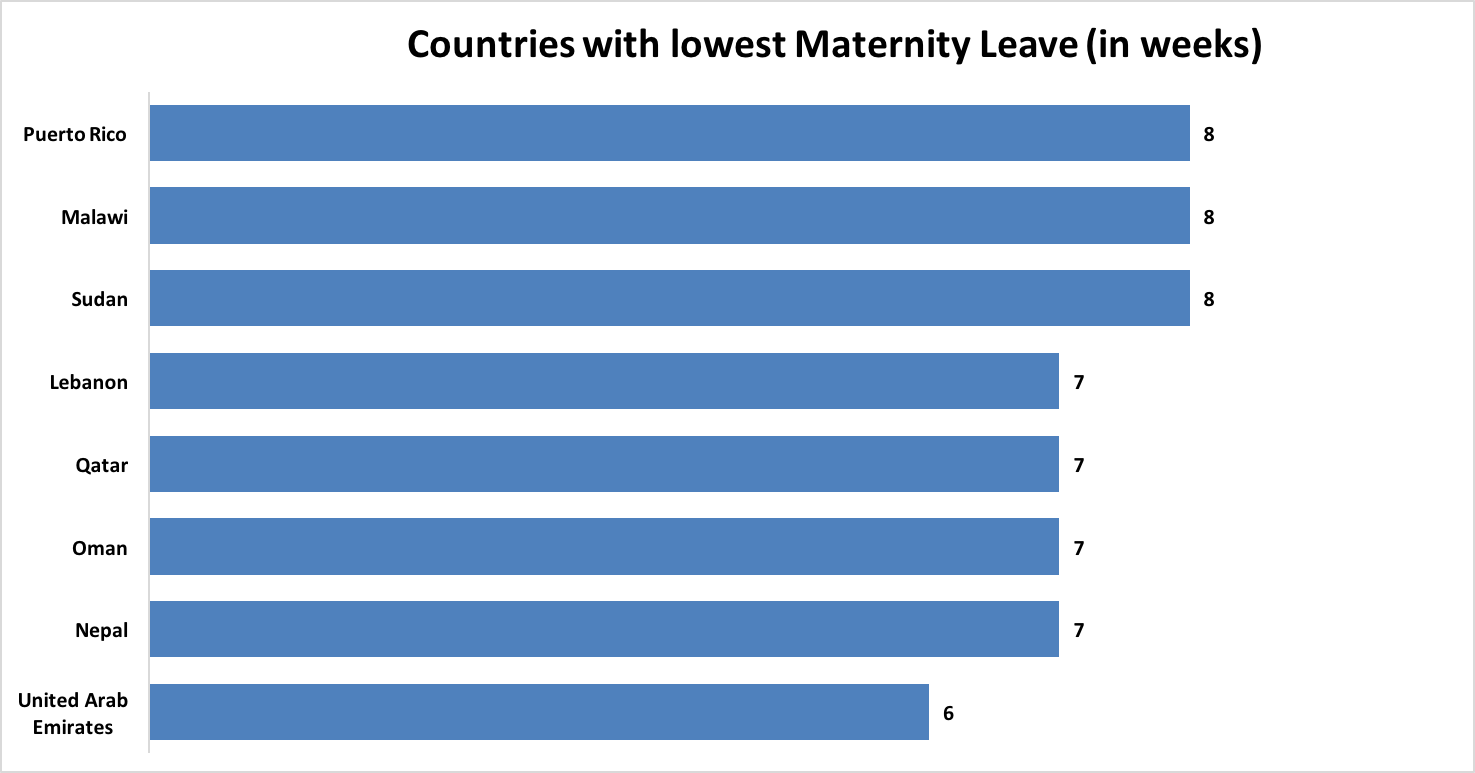[orc]India has passed a law to enhance the maternity leave from 12 to 26 weeks. A look at the maternity & paternity leave policies around the world indicates that India has a long way to go.
International Labour Organization’s (ILO) Maternity and Paternity at Work Report 2014 states that maternity protection is a fundamental right and an element of comprehensive work-family policies. It is crucial for promoting maternal and child health and preventing discrimination against women in the workplace. The goal of maternity protection legislation is to enable women to combine their reproductive and productive roles successfully and promote equal opportunities and treatment in employment and occupation without prejudice to health or economic security.
India passed the ‘Maternity Benefit (Amendment) Bill, 2016’ on March 9th, 2017 extending the maternity leave from 12 weeks to 26 weeks. According to the World Policy Center, the number of countries extending at least 14 weeks of leave has been steadily rising since 1995.
Around the World
While some high-income countries have a generous maternity leave, some countries in Central Asia and Eastern European region like Croatia, give up to 58 weeks, the highest in the world. Besides the countries with highest maternity leave, Czech Republic has 28 weeks and Vietnam, Venezuela and Isle of Man have 26 weeks each along with India.

Source: 2014 ILO Report (Data limited to available data mandated by country laws. Maternity policies are evolving in several countries; some changes outside the report might not been reflected)
According to available data, eight countries do not guarantee paid leave to mothers of infants. These are: Papua New Guinea, Suriname, the United States of America, and 5 small Pacific island states (Marshall Islands, Micronesia, Nauru, Palau, and Tonga).
USA is the only high-income country that does not have a statutory maternity leave policy. Five states in USA have created their own maternity policies; some use their 12 weeks of unpaid family/medical leave and some companies offer it as employee benefits. A US Department of Labor study in 2012 indicated that 23% of the workers who participated in the survey took less than two weeks off to care for their infant making them vulnerable to health risks.
 Paternity or Parental Leave
Paternity or Parental Leave
The inclusion of basic paternity leave or combined family leave provisions would have made India’s bill a historic legislation for two reasons.
- Recognizing the potential contribution of women to the country as well as giving equal protection to their reproductive rights without jeopardizing their right to work.
- Recognizing the role of father as an essential contribution to child rearing and giving them the right to bond with their children without compromising on the financial ability to provide for the family
An IMF working paper in 2015 on Indian women participation in organized labor force discusses that a working wage is chosen by women only if the earnings at least make up for the lost home production, both goods and services like child rearing. This is because majority of household related work in India is assumed as the responsibility of the female partner including parenting. This is one of the barriers that prevent women from participating in the labor force in spite of having the education and the intent. Also, the burden of childcare falls on the female partner triggering them to leave the workforce after childbirth in nuclear families.
ILO’s Maternity and Paternity at Work Report 2014 quotes researcher Erin Rehel on role of the father at home. “By drawing fathers into the daily realities of childcare, free of workplace constraints, extended time off [immediately after the birth]provides the space necessary for fathers to develop the parenting skills and sense of responsibility that then allows them to be active co-parents rather than helpers to their female partners. This shift from a manager-helper dynamic to that of co-parenting creates the opportunity for the development of a more gender-equitable division of labor”
Around the World
Unlike India, a number of countries around the world have paternity leave or parental leave. Some of the best parental leave policies are below:
In Norway, a father can take 10 weeks paid leave to be with his child along with an option of taking 26 weeks of parental leave at 100% pay or 36 weeks of parental leave at 80%. In case the child is in the sole care of mother or father, they can take 10 weeks of mandated leave and are entitled to take the 36 weeks of parental leave. If both parents take 10 weeks each, they still have an additional 36 weeks between them to take care of the child.
In Sweden, more than 68 weeks (480 days) of parental leave can be shared between parents. Out of the 480 days, 90 days are reserved for the fathers. For 390 days, they are entitled to 80% pay and remaining 90 are flat rate benefits. Those who are not employed also are entitled for parental leave
In Denmark, parental leave depends on your employer agreements and it can amount up to 52 weeks. According to general practice mother has the rights for 4 weeks of leave directly before birth and up to 14 weeks after birth. The father is entitled to take weeks and share 32 weeks of parental leave between both parents.
In United Kingdom, the father can take up to 52 weeks, minus the days taken by the mother as maternity leave. The pay is different depending on the weeks taken.
In Germany, father or mother can take up to 52 weeks of parental leave with a minimum of 2 months for each parent. If both parents take at least 2 months, the leave is extended up to 60 weeks.
In Canada, besides the 15 weeks of maternity leave, parents are given 35 weeks of leave that can be shared between them.
Even low-income countries like Tunisia have 1 day of paternity leave. This new maternity bill for India is a lost opportunity to label India as a gender-neutral country in law and practice. Integrating the role of fathers into parental responsibility will allow women to feel equal as well as contribute to their family and country financially. And no law should deny a father his right or want to spend time with his newborn child just because of his gender.
Featured Image:Maternity & Paternity Leave Around the World


